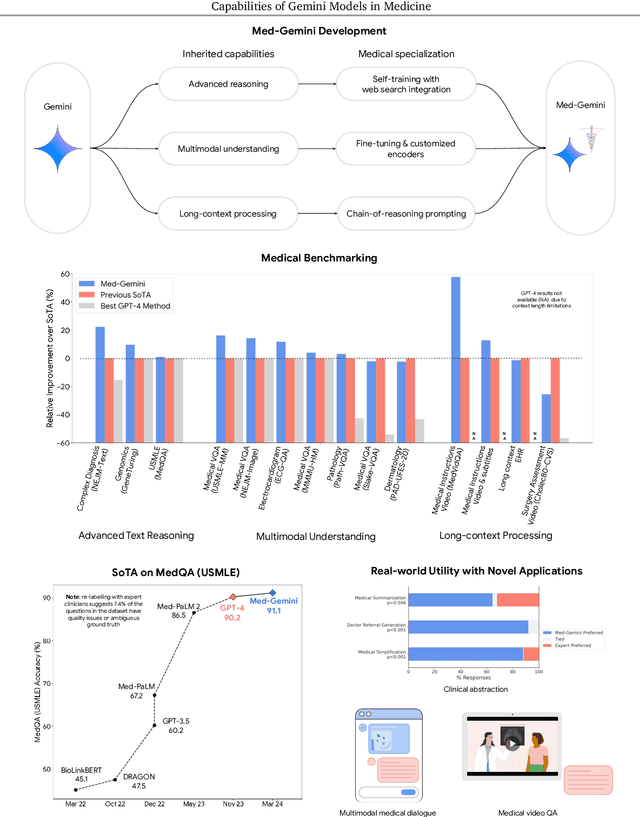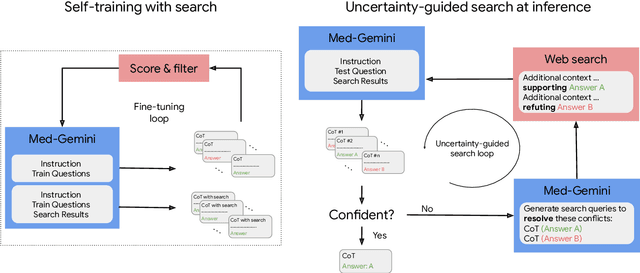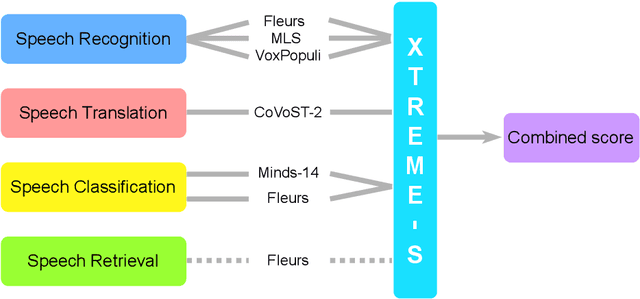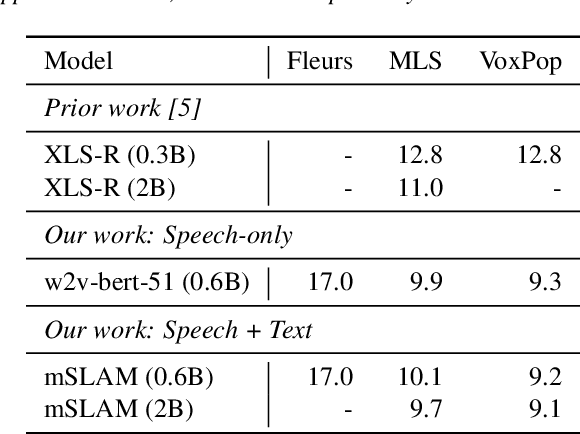Melvin Johnson
Capabilities of Gemini Models in Medicine
May 01, 2024



Abstract:Excellence in a wide variety of medical applications poses considerable challenges for AI, requiring advanced reasoning, access to up-to-date medical knowledge and understanding of complex multimodal data. Gemini models, with strong general capabilities in multimodal and long-context reasoning, offer exciting possibilities in medicine. Building on these core strengths of Gemini, we introduce Med-Gemini, a family of highly capable multimodal models that are specialized in medicine with the ability to seamlessly use web search, and that can be efficiently tailored to novel modalities using custom encoders. We evaluate Med-Gemini on 14 medical benchmarks, establishing new state-of-the-art (SoTA) performance on 10 of them, and surpass the GPT-4 model family on every benchmark where a direct comparison is viable, often by a wide margin. On the popular MedQA (USMLE) benchmark, our best-performing Med-Gemini model achieves SoTA performance of 91.1% accuracy, using a novel uncertainty-guided search strategy. On 7 multimodal benchmarks including NEJM Image Challenges and MMMU (health & medicine), Med-Gemini improves over GPT-4V by an average relative margin of 44.5%. We demonstrate the effectiveness of Med-Gemini's long-context capabilities through SoTA performance on a needle-in-a-haystack retrieval task from long de-identified health records and medical video question answering, surpassing prior bespoke methods using only in-context learning. Finally, Med-Gemini's performance suggests real-world utility by surpassing human experts on tasks such as medical text summarization, alongside demonstrations of promising potential for multimodal medical dialogue, medical research and education. Taken together, our results offer compelling evidence for Med-Gemini's potential, although further rigorous evaluation will be crucial before real-world deployment in this safety-critical domain.
Gemini 1.5: Unlocking multimodal understanding across millions of tokens of context
Mar 08, 2024Abstract:In this report, we present the latest model of the Gemini family, Gemini 1.5 Pro, a highly compute-efficient multimodal mixture-of-experts model capable of recalling and reasoning over fine-grained information from millions of tokens of context, including multiple long documents and hours of video and audio. Gemini 1.5 Pro achieves near-perfect recall on long-context retrieval tasks across modalities, improves the state-of-the-art in long-document QA, long-video QA and long-context ASR, and matches or surpasses Gemini 1.0 Ultra's state-of-the-art performance across a broad set of benchmarks. Studying the limits of Gemini 1.5 Pro's long-context ability, we find continued improvement in next-token prediction and near-perfect retrieval (>99%) up to at least 10M tokens, a generational leap over existing models such as Claude 2.1 (200k) and GPT-4 Turbo (128k). Finally, we highlight surprising new capabilities of large language models at the frontier; when given a grammar manual for Kalamang, a language with fewer than 200 speakers worldwide, the model learns to translate English to Kalamang at a similar level to a person who learned from the same content.
Gemini: A Family of Highly Capable Multimodal Models
Dec 19, 2023Abstract:This report introduces a new family of multimodal models, Gemini, that exhibit remarkable capabilities across image, audio, video, and text understanding. The Gemini family consists of Ultra, Pro, and Nano sizes, suitable for applications ranging from complex reasoning tasks to on-device memory-constrained use-cases. Evaluation on a broad range of benchmarks shows that our most-capable Gemini Ultra model advances the state of the art in 30 of 32 of these benchmarks - notably being the first model to achieve human-expert performance on the well-studied exam benchmark MMLU, and improving the state of the art in every one of the 20 multimodal benchmarks we examined. We believe that the new capabilities of Gemini models in cross-modal reasoning and language understanding will enable a wide variety of use cases and we discuss our approach toward deploying them responsibly to users.
XTREME-UP: A User-Centric Scarce-Data Benchmark for Under-Represented Languages
May 24, 2023



Abstract:Data scarcity is a crucial issue for the development of highly multilingual NLP systems. Yet for many under-represented languages (ULs) -- languages for which NLP re-search is particularly far behind in meeting user needs -- it is feasible to annotate small amounts of data. Motivated by this, we propose XTREME-UP, a benchmark defined by: its focus on the scarce-data scenario rather than zero-shot; its focus on user-centric tasks -- tasks with broad adoption by speakers of high-resource languages; and its focus on under-represented languages where this scarce-data scenario tends to be most realistic. XTREME-UP evaluates the capabilities of language models across 88 under-represented languages over 9 key user-centric technologies including ASR, OCR, MT, and information access tasks that are of general utility. We create new datasets for OCR, autocomplete, semantic parsing, and transliteration, and build on and refine existing datasets for other tasks. XTREME-UP provides methodology for evaluating many modeling scenarios including text-only, multi-modal (vision, audio, and text),supervised parameter tuning, and in-context learning. We evaluate commonly used models on the benchmark. We release all code and scripts to train and evaluate models
PaLM 2 Technical Report
May 17, 2023



Abstract:We introduce PaLM 2, a new state-of-the-art language model that has better multilingual and reasoning capabilities and is more compute-efficient than its predecessor PaLM. PaLM 2 is a Transformer-based model trained using a mixture of objectives. Through extensive evaluations on English and multilingual language, and reasoning tasks, we demonstrate that PaLM 2 has significantly improved quality on downstream tasks across different model sizes, while simultaneously exhibiting faster and more efficient inference compared to PaLM. This improved efficiency enables broader deployment while also allowing the model to respond faster, for a more natural pace of interaction. PaLM 2 demonstrates robust reasoning capabilities exemplified by large improvements over PaLM on BIG-Bench and other reasoning tasks. PaLM 2 exhibits stable performance on a suite of responsible AI evaluations, and enables inference-time control over toxicity without additional overhead or impact on other capabilities. Overall, PaLM 2 achieves state-of-the-art performance across a diverse set of tasks and capabilities. When discussing the PaLM 2 family, it is important to distinguish between pre-trained models (of various sizes), fine-tuned variants of these models, and the user-facing products that use these models. In particular, user-facing products typically include additional pre- and post-processing steps. Additionally, the underlying models may evolve over time. Therefore, one should not expect the performance of user-facing products to exactly match the results reported in this report.
The unreasonable effectiveness of few-shot learning for machine translation
Feb 02, 2023



Abstract:We demonstrate the potential of few-shot translation systems, trained with unpaired language data, for both high and low-resource language pairs. We show that with only 5 examples of high-quality translation data shown at inference, a transformer decoder-only model trained solely with self-supervised learning, is able to match specialized supervised state-of-the-art models as well as more general commercial translation systems. In particular, we outperform the best performing system on the WMT'21 English - Chinese news translation task by only using five examples of English - Chinese parallel data at inference. Moreover, our approach in building these models does not necessitate joint multilingual training or back-translation, is conceptually simple and shows the potential to extend to the multilingual setting. Furthermore, the resulting models are two orders of magnitude smaller than state-of-the-art language models. We then analyze the factors which impact the performance of few-shot translation systems, and highlight that the quality of the few-shot demonstrations heavily determines the quality of the translations generated by our models. Finally, we show that the few-shot paradigm also provides a way to control certain attributes of the translation -- we show that we are able to control for regional varieties and formality using only a five examples at inference, paving the way towards controllable machine translation systems.
Mu$^{2}$SLAM: Multitask, Multilingual Speech and Language Models
Dec 19, 2022



Abstract:We present Mu$^{2}$SLAM, a multilingual sequence-to-sequence model pre-trained jointly on unlabeled speech, unlabeled text and supervised data spanning Automatic Speech Recognition (ASR), Automatic Speech Translation (AST) and Machine Translation (MT), in over 100 languages. By leveraging a quantized representation of speech as a target, Mu$^{2}$SLAM trains the speech-text models with a sequence-to-sequence masked denoising objective similar to T5 on the decoder and a masked language modeling (MLM) objective on the encoder, for both unlabeled speech and text, while utilizing the supervised tasks to improve cross-lingual and cross-modal representation alignment within the model. On CoVoST AST, Mu$^{2}$SLAM establishes a new state-of-the-art for models trained on public datasets, improving on xx-en translation over the previous best by 1.9 BLEU points and on en-xx translation by 1.1 BLEU points. On Voxpopuli ASR, our model matches the performance of an mSLAM model fine-tuned with an RNN-T decoder, despite using a relatively weaker sequence-to-sequence architecture. On text understanding tasks, our model improves by more than 6\% over mSLAM on XNLI, getting closer to the performance of mT5 models of comparable capacity on XNLI and TydiQA, paving the way towards a single model for all speech and text understanding tasks.
XTREME-S: Evaluating Cross-lingual Speech Representations
Apr 13, 2022



Abstract:We introduce XTREME-S, a new benchmark to evaluate universal cross-lingual speech representations in many languages. XTREME-S covers four task families: speech recognition, classification, speech-to-text translation and retrieval. Covering 102 languages from 10+ language families, 3 different domains and 4 task families, XTREME-S aims to simplify multilingual speech representation evaluation, as well as catalyze research in "universal" speech representation learning. This paper describes the new benchmark and establishes the first speech-only and speech-text baselines using XLS-R and mSLAM on all downstream tasks. We motivate the design choices and detail how to use the benchmark. Datasets and fine-tuning scripts are made easily accessible at https://hf.co/datasets/google/xtreme_s.
mSLAM: Massively multilingual joint pre-training for speech and text
Feb 03, 2022Abstract:We present mSLAM, a multilingual Speech and LAnguage Model that learns cross-lingual cross-modal representations of speech and text by pre-training jointly on large amounts of unlabeled speech and text in multiple languages. mSLAM combines w2v-BERT pre-training on speech with SpanBERT pre-training on character-level text, along with Connectionist Temporal Classification (CTC) losses on paired speech and transcript data, to learn a single model capable of learning from and representing both speech and text signals in a shared representation space. We evaluate mSLAM on several downstream speech understanding tasks and find that joint pre-training with text improves quality on speech translation, speech intent classification and speech language-ID while being competitive on multilingual ASR, when compared against speech-only pre-training. Our speech translation model demonstrates zero-shot text translation without seeing any text translation data, providing evidence for cross-modal alignment of representations. mSLAM also benefits from multi-modal fine-tuning, further improving the quality of speech translation by directly leveraging text translation data during the fine-tuning process. Our empirical analysis highlights several opportunities and challenges arising from large-scale multimodal pre-training, suggesting directions for future research.
DOCmT5: Document-Level Pretraining of Multilingual Language Models
Dec 16, 2021



Abstract:In this paper, we introduce DOCmT5, a multilingual sequence-to-sequence language model pre-trained with large scale parallel documents. While previous approaches have focused on leveraging sentence-level parallel data, we try to build a general-purpose pre-trained model that can understand and generate long documents. We propose a simple and effective pre-training objective - Document Reordering Machine Translation (DrMT), in which the input documents that are shuffled and masked need to be translated. DrMT brings consistent improvements over strong baselines on a variety of document-level generation tasks, including over 12 BLEU points for seen-language-pair document-level MT, over 7 BLEU points for unseen-language-pair document-level MT and over 3 ROUGE-1 points for seen-language-pair cross-lingual summarization. We achieve state-of-the-art (SOTA) on WMT20 De-En and IWSLT15 Zh-En document translation tasks. We also conduct extensive analysis on various factors for document pre-training, including (1) the effects of pre-training data quality and (2) The effects of combining mono-lingual and cross-lingual pre-training. We plan to make our model checkpoints publicly available.
 Add to Chrome
Add to Chrome Add to Firefox
Add to Firefox Add to Edge
Add to Edge